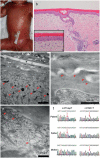Novel TGM1 Gene Mutation in a Japanese Patient with Bathing Suit Ichthyosis
- PMID: 32965503
- PMCID: PMC9274925
- DOI: 10.2340/00015555-3643
Novel TGM1 Gene Mutation in a Japanese Patient with Bathing Suit Ichthyosis
Keywords: cholesterol clefts; electron microscopy; lamellar granules; transglutaminase 1; bathing suit ichthyosis.
Figures


Similar articles
-
Bathing suit ichthyosis: Two Burmese siblings and a review of the literature.Pediatr Dermatol. 2020 Jan;37(1):165-170. doi: 10.1111/pde.14030. Epub 2019 Oct 20. Pediatr Dermatol. 2020. PMID: 31631373 Review.
-
Bathing suit ichthyosis caused by a TGM1 mutation in a Tunisian child.Int J Dermatol. 2014 Dec;53(12):1478-80. doi: 10.1111/ijd.12569. Epub 2014 Sep 10. Int J Dermatol. 2014. PMID: 25209454
-
Expanding the Genotypic Spectrum of Bathing Suit Ichthyosis.JAMA Dermatol. 2017 Jun 1;153(6):537-543. doi: 10.1001/jamadermatol.2017.0202. JAMA Dermatol. 2017. PMID: 28403434 Free PMC article.
-
Genotype-phenotype correlations with TGM1: clustering of mutations in the bathing suit ichthyosis and self-healing collodion baby variants of lamellar ichthyosis.Br J Dermatol. 2010 Feb 1;162(2):448-51. doi: 10.1111/j.1365-2133.2009.09537.x. Epub 2009 Oct 26. Br J Dermatol. 2010. PMID: 19863506 No abstract available.
-
Bathing suit ichthyosis.Eur J Dermatol. 2010 Jul-Aug;20(4):447-50. doi: 10.1684/ejd.2010.1008. Epub 2010 Jun 3. Eur J Dermatol. 2010. PMID: 20522418 Review.
Cited by
-
Novel Homozygous Mutations in the Genes TGM1, SULT2B1, SPINK5 and FLG in Four Families Underlying Congenital Ichthyosis.Genes (Basel). 2021 Mar 5;12(3):373. doi: 10.3390/genes12030373. Genes (Basel). 2021. PMID: 33807935 Free PMC article.
References
-
- Oji V, Tadini G, Akiyama M, et al. . Revised nomenclature and classification of inherited ichthyoses: results of the First Ichthyosis Consensus Conference in Sorèze 2009. J Am Acad Dermatol 2010; 63: 607–641. - PubMed
-
- Jacyk WK. Bathing-suit ichthyosis. A peculiar phenotype of lamellar ichthyosis in South African blacks. Eur J Dermatol 2005; 15: 433–436. - PubMed
-
- Oji V, Hautier JM, Ahvazi B, et al. . Bathing suit ichthyosis is caused by transglutaminase-1 deficiency: evidence for a temperature-sensitive phenotype. Hum Mol Genet 2006; 15: 3083–3097. - PubMed
-
- Sakai K, Akiyama M, Yanagi T, et al. . ABCA12 is a major causative gene for non-bullous congenital ichthyosiform erythroderma. J Invest Dermatol 2009; 129: 2306–2309. - PubMed
Publication types
MeSH terms
Substances
LinkOut - more resources
Full Text Sources

